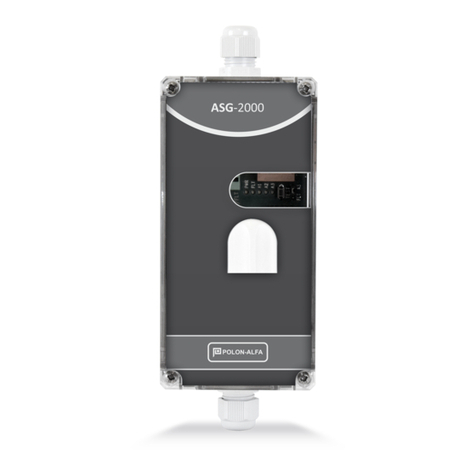IK-E363-001 10
8.2. Test of the detection function.
Using a suitable test cap at a flow rate of 0.5 l/min, provide the test gas:
•for PSG-6x03 containing 100 ÷ 200 ppm CO for a time suitable for triggering alarm 1 or 3,
•for PSG-6001 and PSG-6002 containing> 20% LEL of gas detected until the alarm is triggered.
When detecting a small amount of gas, the POWER diode is permanently lit with short stops every 2.5
seconds, allowing the test to be performed in a shorter time and not subjecting the sensors to a
significant concentration of gas for too long.
9. SAFETY CONDITIONS.
9.1. Repairs and maintenance.
Maintenance and periodic inspections must be carried out by authorized personnel of companies
authorized or trained by Polon-Alfa.
All repairs must be made by the manufacturer.
Polon-Alfa shall not be liable for the operation of equipment maintained and repaired by unauthorized
personnel.
9.2. Work at heights.
Work at heights related to the installation of detectors should be carried out with extreme caution
when using efficient equipment and tools.
Special attention should be paid to the stability of ladders, lifts, etc.
Power tools should be used with observance of the conditions of their safe operation specified in the
relevant manufacturer's instructions.
9.3. Eye protection against dust.
During work that causes the formation of a large amount of dust, especially drilling holes in the ceilings
to attach detectors, use safety goggles and dust masks.
10. STORAGE AND TRANSPORT.
10.1. Storage.
The detectors should be stored in closed rooms where no vapours or caustic gases are present, the
temperature is in the range from 0° C to +40° C, and the relative humidity does not exceed 80% at +35°
C.
During storage, the detector should not be exposed to direct sunlight or heat from heating devices.
The period of storing the detector in the transport packaging should not exceed 6 months.
10.2. Transport.
Detectors should be transported in closed spaces of means of transport, in a packaging that meets the
requirements of applicable transport regulations. The temperature during transport should not be
lower than -20° C and higher than +50° C, and relative humidity not greater than 95% at +45° C or 80%
at +50° C.
IK-E363-001/20.12.2017



























